Come for the cat, stay for the tentacles.
Type: Single-player
Genre: Adventure, Point & Click
Developer: Stuck In Attic
Publisher: Stuck In Attic
Release date: 7 August, 2019


Gibbous – A Cthulhu Adventure, the new adventure game from Stuck In Attic, begins with a noir-obsessed gumshoe chasing after the mythical Necronomicon, which quickly spirals out of control to involve some unwitting allies like an eternally optimistic but naive librarian, a talking cat, a mysterious rebel, and a one very unassuming little girl whose fish doll you do not want to mess with. Their adventures take them through the Lovecraft inspired mystical town of Darkham, to the fishy (both suspicious and smelly) Fishmouth, and even across the globe with pit-stops in Paris and Transylvania. Along the way you’ll be chased by crazed cultists, eyed by cannibalistic townsfolk, outwit Count Vlad in a rap battle, and get transformed into a tentacle monster, more than once. Will you stop the world-dominating plans of “The Butcher” in time, or succumb to the curse of the book? But the bigger mystery is, what exactly is a gibbous in the first place?
Adventure games tend not to have many ingredients, which makes them appear deceptively simple on the surface; but, as with many things, it’s how you use these few elements that determines the success of the whole. In looking at the isolated elements that make up Gibbous, it could effectively be reduced to graphics, storytelling, and puzzles. Is it enough, then, that only some of these elements are truly outstanding? Can excellent visuals and audio support the weight of the rest of the game? Whereas most games might struggle under a similar strain, Gibbous succeeds due to its sheer enthusiasm; and basing the game around a talking cat doesn’t hurt, either.
Graphics and Animation
The most prominent aspects that comes up when discussing this game are the expert animations and amazing artwork. I’ve been fortunate enough to have reviewed several great adventure games so far this year, but of them, the visuals in Gibbous are a masterful win. And it’s more than just a single visual element; the brilliant character design, lovingly detailed sets and backgrounds, stylized prop illustrations, inventive cutscene animations, slick user interface, and lush color palette all combine together in an orchestrated way that not only brings the darkly comic world of Darkham to life, but successfully engages the player’s imagination in the process.
The highlight, of course, are the animations themselves. They are wonderfully expressive, fluidly executed, and have flawless comedic timing; when you solve enough of the puzzles in a chapter to unlock the next section, seeing the cut scene animation as a result is a reward in and of itself. They’re very well staged too, and often the game feels like you’re controlling an interactive animated series. Most of the animation has a cut-out style to it, but this is punctuated by more detailed moments, such as when a character throws a temper tantrum, or there’s a dramatic camera angle. As previously implied, the game does earn bonus points for featuring a cat as one of the main characters, and her animations are particularly well done; both matching real cat-isms frame-by-frame, as well as exaggerating them in an appealingly feline way.
The only cheat is the lip sync. There is no lip sync, the mouths just randomly cycle through various shapes. The effect is intentional, no doubt, to save money on the copious dialogue, but also to allow for different language localization. Because it’s done with such a knowing flair, the silliness of it all actually works with the overall humor in the game; so even though the random mouth flapping may seem odd at a glance, it does work in context of the game.
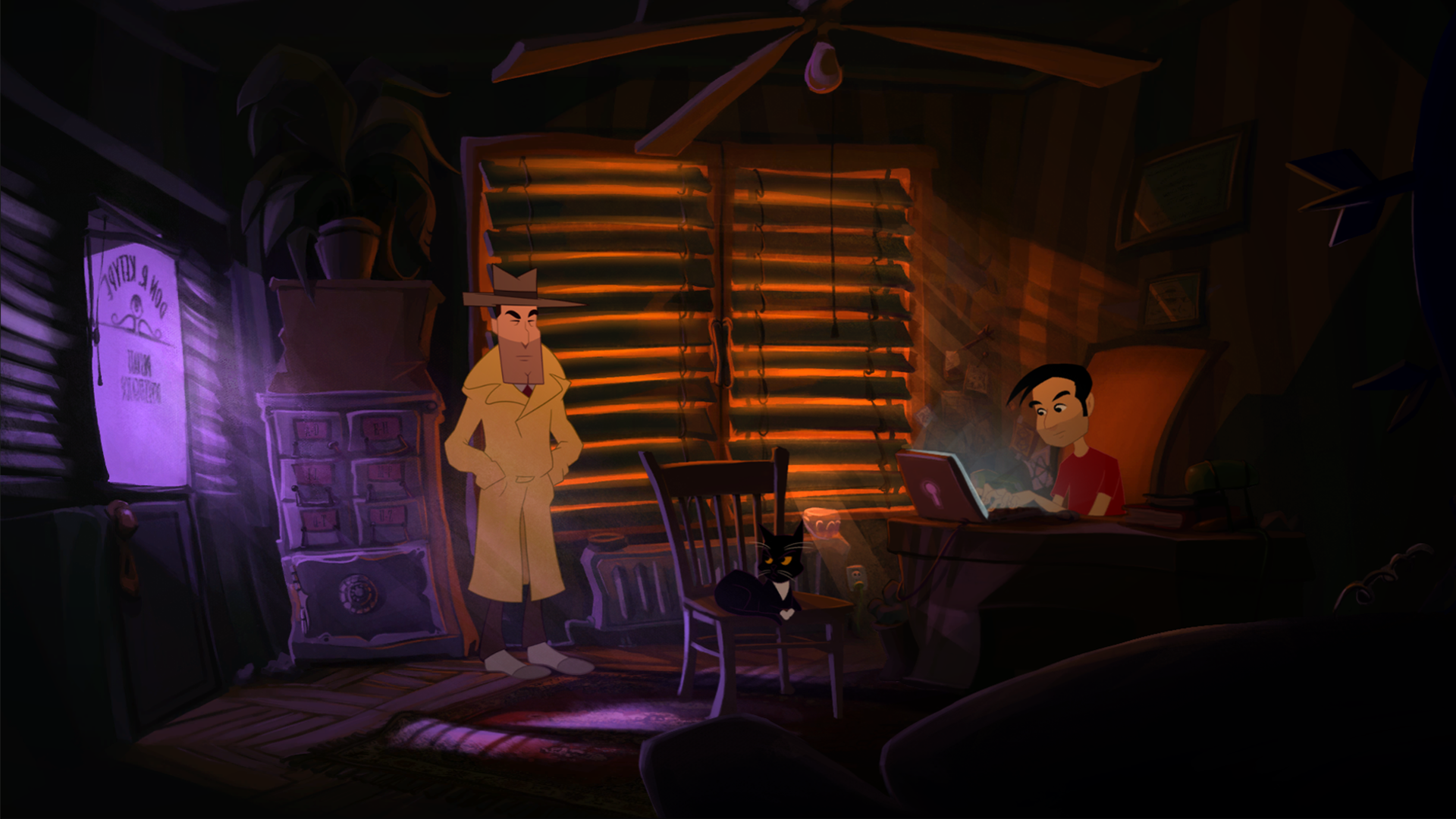
The set illustrations are deliciously lovely. The layout of each screen is creatively unique, and also is designed in a way to help with eye flow, guiding the player across the screen as they look for clues. The level of detail is perfect, and the worlds of Darkham, Fishmouth, Paris and Transylvania are rich, evocative, and “lived-in”, with tons of throw-away ornaments whose sole existence is to adorn an already pretty picture. The color palette excels in using simple but bold schemes to convey mood and help tell the story. My only complaint with any of the visuals is that on a few occasions the backgrounds are just a tad bit too dark. Some of this is by design of course, but other times it just unnecessarily muddies up the otherwise imaginative illustrations. It really only affects a few of the scenes, and it’s not like it ruins the gameplay, it just obscures more of the gorgeous artwork than I’d otherwise prefer.
The character designs are pitch-perfect, gangly where need be, and adorable where appropriate, they’re easy to love and laugh along-side with, and sometimes at. This is a fully voiced adventure game, so the visual design is only one of the components that brings each character to life, the voluminous voice acting does the rest. For better or worse, Gibbous contains a lot of dialogue, maybe too much at times. You can skip through it with just a mouse-click, but with no way of repeating most dialogue options, if you miss something important you’ll not get a second chance. So, to play it safe, you’ll probably want to sit through most of it. Sometimes this is easier than others, mostly depending on the character. Being an independently produced game, the voice acting varies considerably, from truly superb, to passably-acceptable. Normally this isn’t an issue in such a game, but because there’s just so much dialogue in Gibbous, if there’s a voice or characterization that feels off to you, it can become irritating quickly. Please note, none of this is a deal breaker, but it’s just a bit disappointing to pair perfect animation with uneven voice work, only because the game is so heavily dependent on both. However, one of the saving graces of the game, is that it frequently shifts perspective across it’s seven chapters; so you’ll have a chance to play the game through each of the main characters. This not only breaks up the monotony, but also allows you to spend more time with your favorite characters, whichever those might be.
Storytelling
To be fair, some of the over-acting comes from the writing, too. The game is ambitious, and that alone is commendable, since there’s so much dialogue and so many different characters scattered throughout the game. The writing is unceasingly trying its hardest to make each moment humorous, though unfortunately comedy is very subjective, so the results may fall flat more often than they succeed. But, there’s a certain air of absolute conviction and determination from the developers that even though many of the jokes fall flat, they do so with such energy and enthusiasm, that you wind up smiling anyway. On the flip side, there are some truly wonderful gems in there, such as numerous nerdly in-jokes, to Python-esque sequences, to witty character sniping as they banter back and forth. In other words, the game takes the “throw it all at the wall and see what sticks” approach; it might be a bit of a mess at times, but it’s a fun mess.
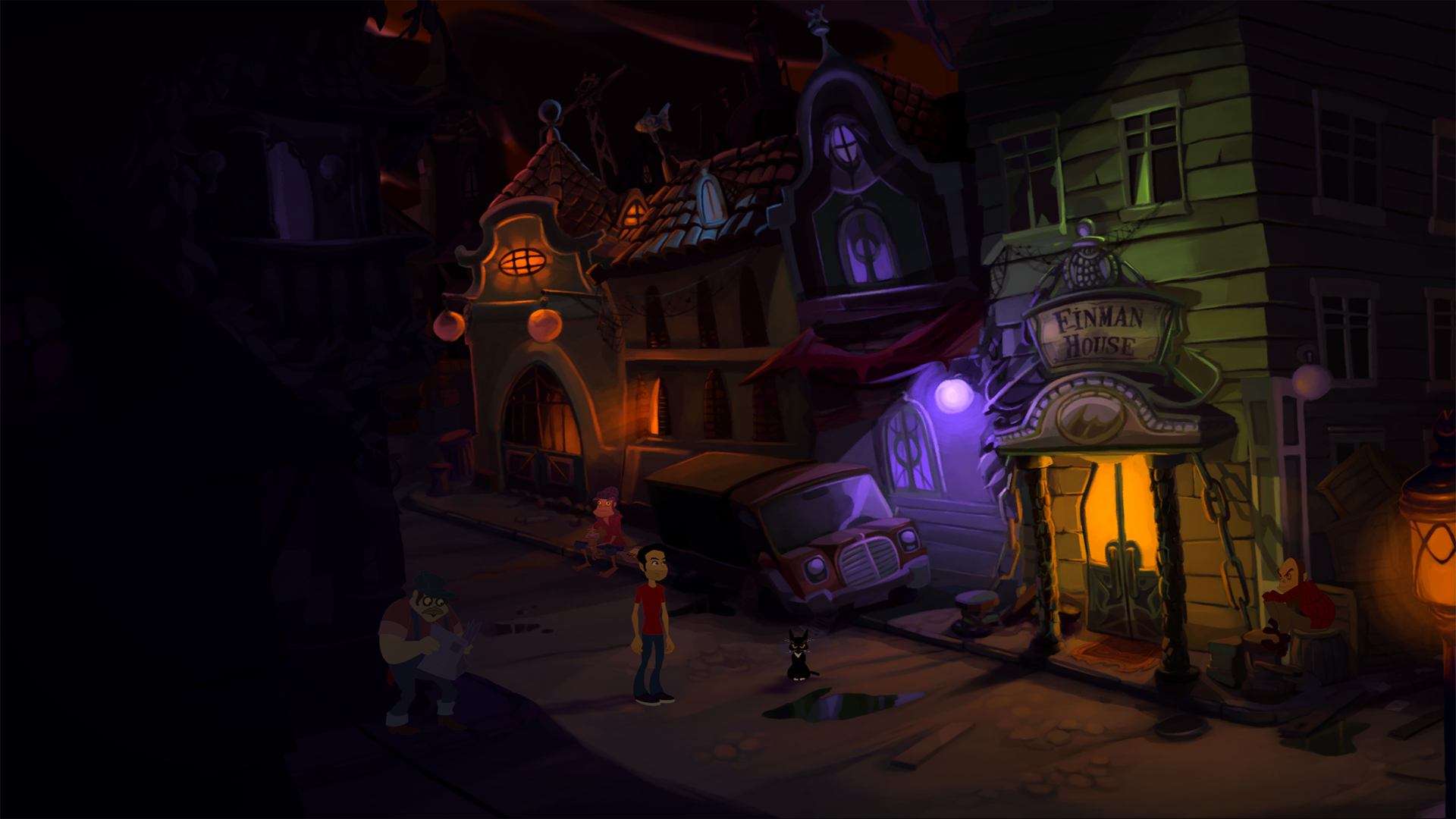
Ultimately, lovely pictures are just images, and perfectly paired voice acting is just noise, unless they’re both at the service of a deserving story. In this aspect, Gibbous struggles a bit. Subjective humor aside, the story isn’t as mystical as the title would have you believe, and mostly focuses on the mundane. The problem is that there is actually some great storytelling content, with wonderfully dramatic sequences and lively character actions, but they don’t occur until the last third of the game. The first two thirds are very slow, a bit aimless, and feel heavily padded. More importantly, they don’t feel Cthulhu-y; specifically, there’s no discernible mood, tension or suspense, which makes playing through the scenes, however beautiful, a bit of a chore. It’s not that there’s anything bad or broken about the story; it’s just feels narratively directionless at times, and a bit too non-magical/non-horror, which is a shame given that’s supposed to be the entire theme of the game. Although it may be tempting to give up, it is worth sticking with the game, as the story does pick up, and eventually comes to a very satisfying conclusion that more than lives up to its title.
Puzzles and Gameplay
The puzzles, on the other hand, were openly disappointing. Again, I have to stress, that like the game’s other flaws, nothing here will ruin the experience of playing, rather the puzzles are very middle-of-the-road; this is perfectly fine for what it is, but only disappointing considering how high quality the other elements of the game are. There are a few notable exceptions, but most of the puzzles are either too forced, too simple, or too anti-climactic.
By forced, I mean that many of the puzzles don’t seem to have a reason for being, other than to act as an obstacle for you to solve; they don’t feel like they’re contributing meaningfully to the progression of the story. For example (no spoilers), one puzzle requires that you fix a village’s internet connection; you’d assume then that the brunt of the puzzle solving would revolve around fixing the modem. But no, the entire action is concentrated on getting you through the door the modem is behind; once you gain entrance into the room, the main characters magically fix everything (off-screen), and then you’re done. So, why then, in a game revolving around the Necronomicon, talking cats, and unspeakable monsters, am I spending time solving a door puzzle?
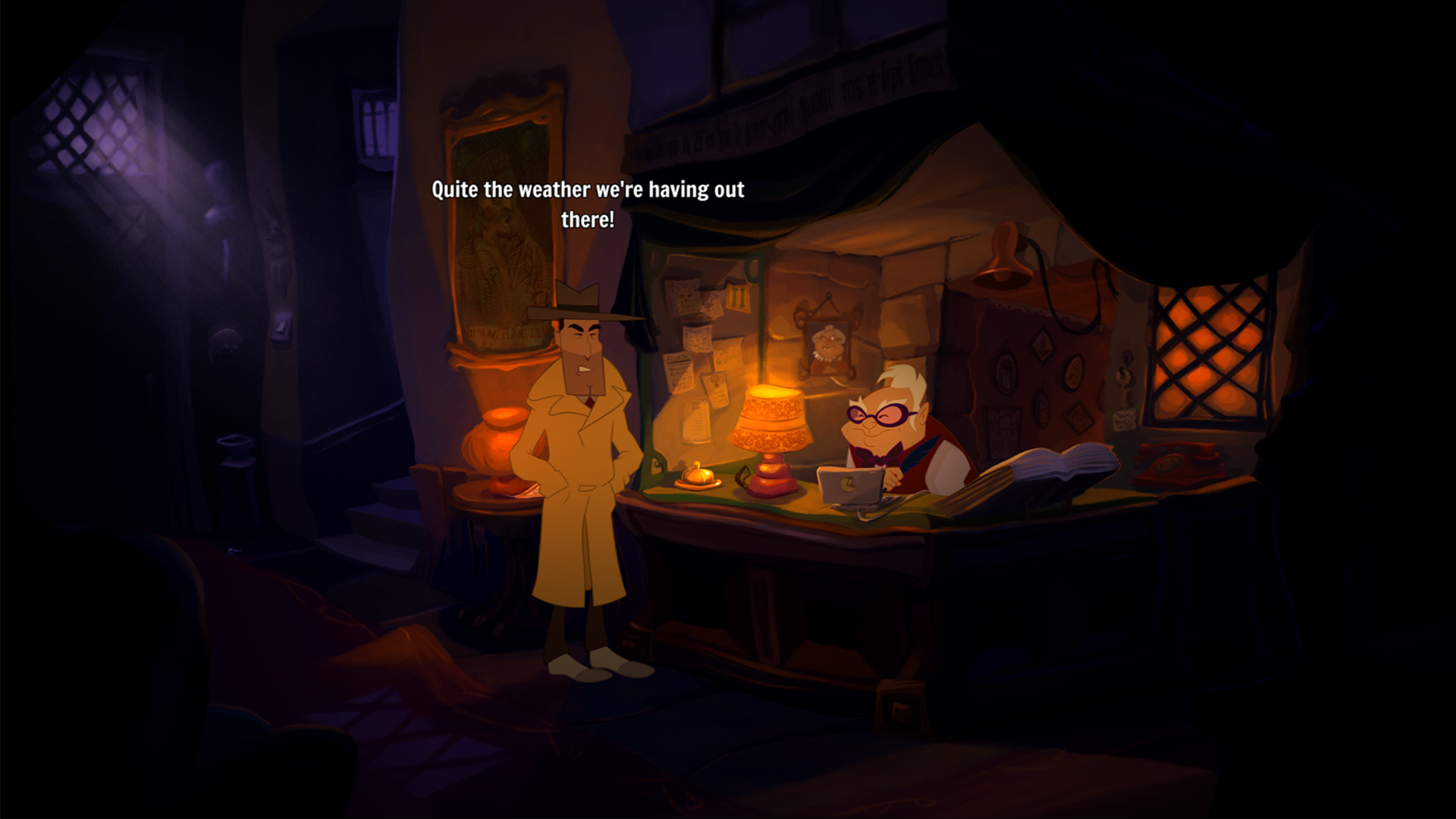
When I say that a puzzle is too simple, this can be both a blessing and a curse. On one hand, the game is quite easy, which makes it very accessible for all gamers, especially newcomers to the adventure genre. On the other hand, many of the puzzles are very linear, very A to B. What I mean by that is some of the most memorable puzzles in other adventure games involve a Rube Goldberg-esque solution, where a puzzle is solved through a chain of seemingly unrelated events; the discovery of which provides the thrill of the puzzle. In Gibbous, the solutions, when you find them, are so clearly obvious that there’s little thrill or sense of victory. It’s just one more obstacle to check off the list.
To call a puzzle anti-climactic is an odd thing to say, but in a few instances of playing Gibbous, this was quite true. Again, not to give anything away, but as an example, one puzzle requires you to convince someone to eat a “tainted” cookie; doing so requires going through quite a few unnecessary steps, and solving other puzzles in the meantime, only to find out that the entire thing was pointless, as the story takes a sudden left-turn, and pulls an almost literal deus-ex-machina-moment and solves the scenario for you. Perhaps this would’ve been easier to stomach if it were a clever turn of events, but to me it felt like a cheat.
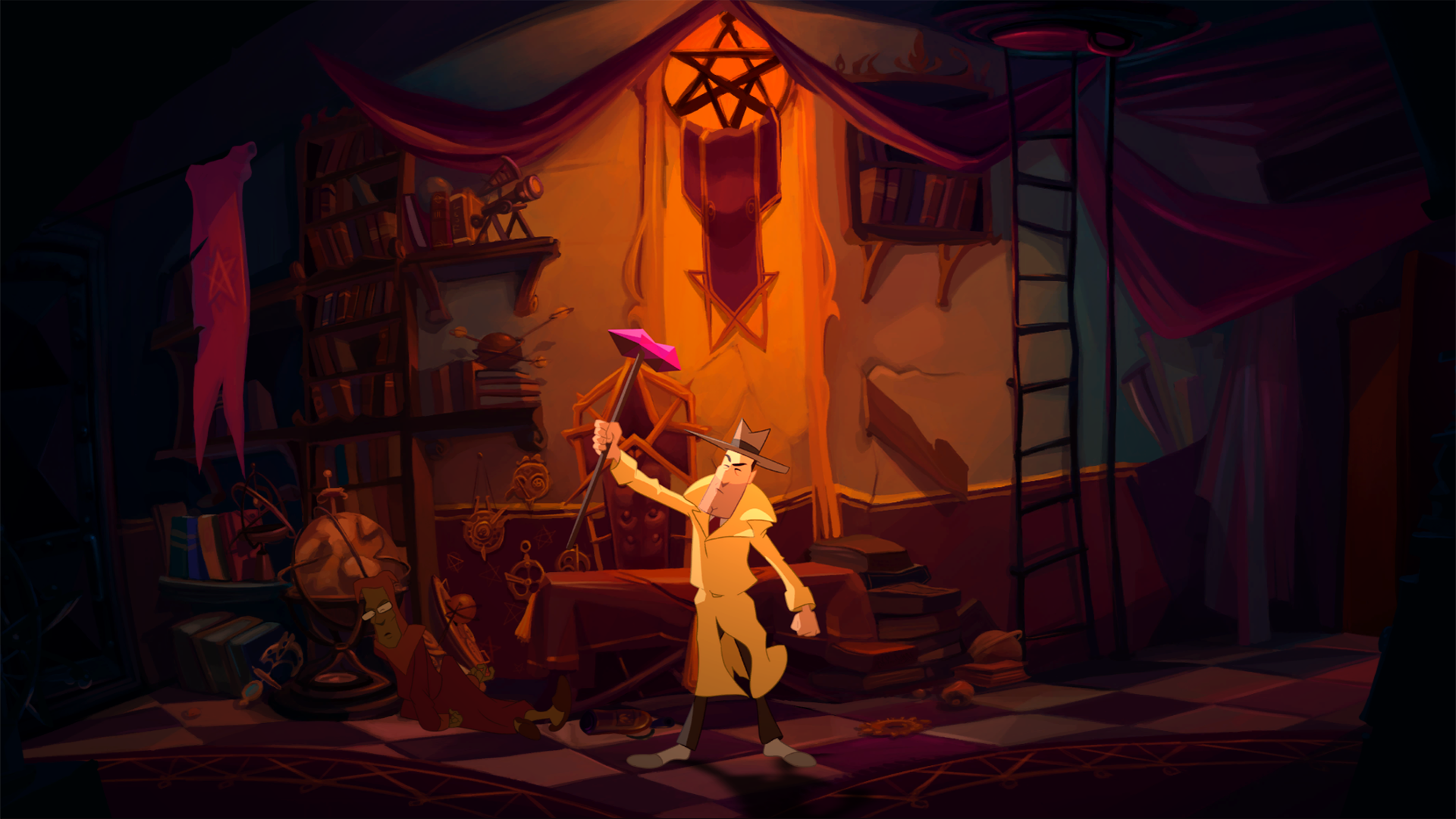
There are exceptions to this, which do successfully represent the full potential of the puzzles, but these moments, much like the story, don’t really come into play until you’ve slogged through a good deal of the game’s more mundane aspects. One such puzzle involves a summoning circle and a bunch of untranslatable books. This sequence gives the player a lot to discover and ponder, and the results, while simple once you know it, are fun and rewarding. I only wish the game had more puzzles like this with similar depth and narrative purpose.
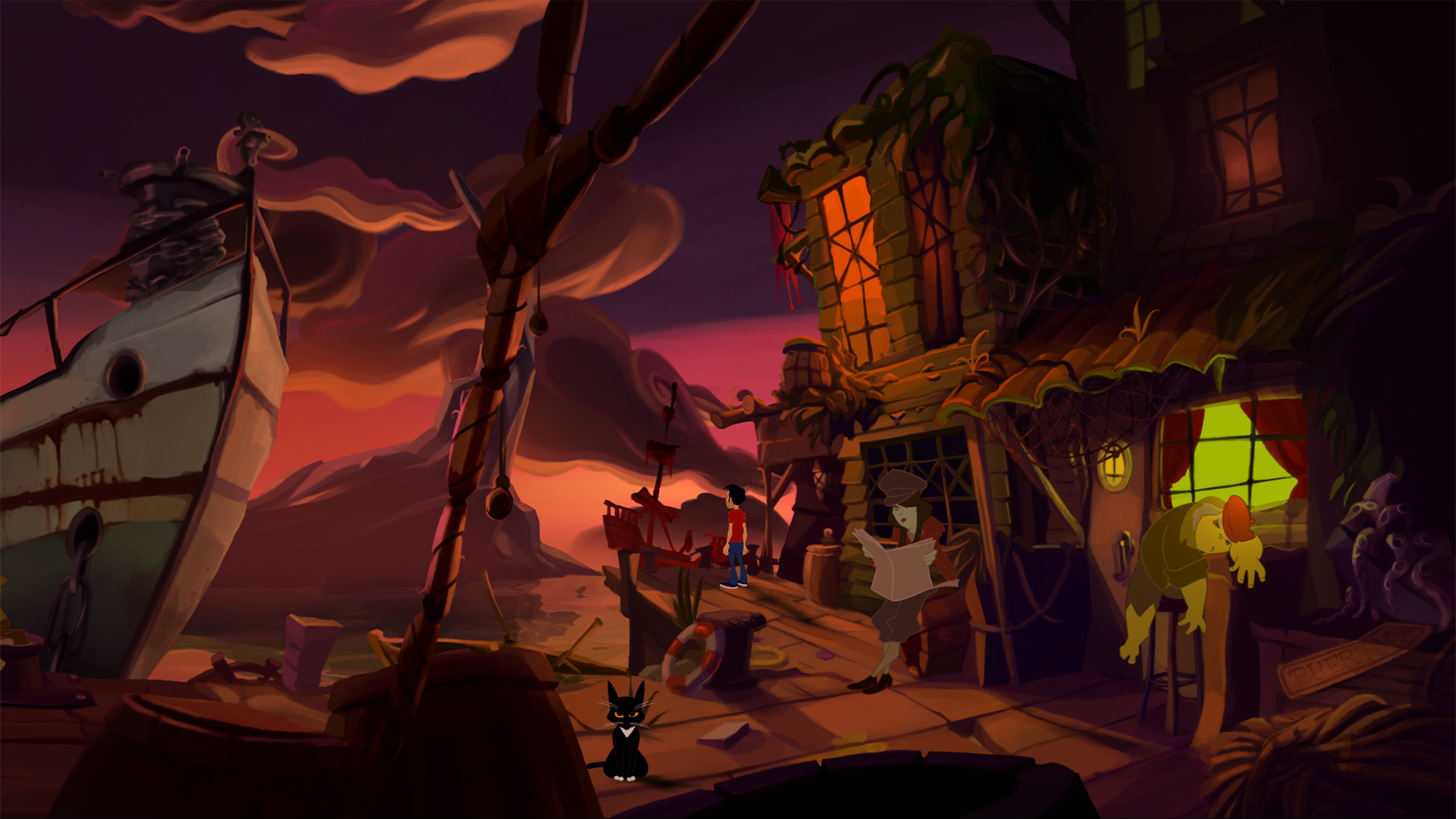
Puzzle design aside, the act of actually solving them, and of playing the game itself, is wonderful. The controls and UI are perfect, and keep just enough of the old-school adventure mechanics alive, while streamlining everything to feel modern. There are various ways to control the character’s movements, and various speeds to traverse the game’s many screens, making it easy and efficient to go where you need, even for puzzles that require lots of back and forth. Inventory and interacting with objects is very smooth, with no guesswork or uncertainty for the player. There’s even added variety in each character’s unique set of abilities. For example, your constant cat companion can leap about to high places. My favorite special ability, though, is bestowed on the detective character, who can touch an object and see the past. This literally brings a new layer of storytelling to the game, and provides fresh insight into scenes you may have previously explored as another character.
Verdict
So, the game does have it’s flaws…the story takes too long to get started, the dialogue is intermittently hammy, the voice acting is uneven, and the puzzles are very mediocre…but the art, characters, interaction, animation and ultimate narrative trajectory, make Gibbous worth every point and every click. The game lasts between 10-12 hours, depending on how much time you spend looking through each shadowy nook and cranny. There’s enough content and variety, along with a solid stable of characters, to fill the game’s seven chapters and gives you the momentum to dive into the next. For all its rough spots, the game has such energy and charisma that even when it’s not entirely successful, there’s enough charm to keep you playing.
According to the game’s story, a gibbous moon is needed to unlock all the power of the Necronomicon; luckily, Gibbous – A Cthulhu Adventure, doesn’t need any lunar help to successfully weave its spell.

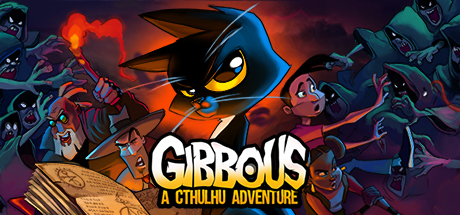









Reminds me so much of old LucasArts games like Secret of Monkey Island or Full Throttle.